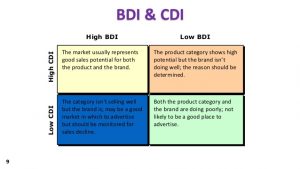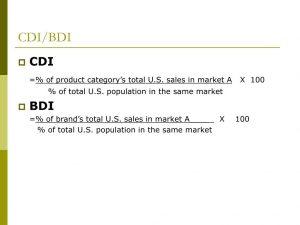Finding ways to distribute marketing budgets is an important priority for many marketers. When marketers are getting ready to run advertising campaigns, they must know where the best areas are to spend money and have the best return on investment possible. In order to come up with an efficient mix of marketing dollar disbursement, marketers put together different methods in order to obtain the absolute maximum effect. Marketers strive to spend the least amount of money possible in terms of advertising yet still reach a large audience. One technique which they use in order to reach this outcome is the brand development index, or BDI.

According to an article on Cleverism, the brand development index is used for identifying the relationship between the total sales of a brand in a particular market and the total population in the market. The article uses the Coca-Cola Company as an example, stating that to calculate the BDI for any particular region in the US, Coke must calculate its sales in that particular region as a percentage of its total sales in the US. This is then compared with the population of the region in question as a percentage of the total population of the US. The formula used is: BDI= [Brand sales to region / Population in region] / [Total brand sales + Total population]. As Informit better describes it, the BDI Is basically a measure of brand sales per person or per household within a specified demographic group, compared with its average sales per person or household in the market as a whole.
 After attaining these calculations, brands can decide whether they want to spend more or less marketing dollars compared to what the market’s BDI is. More of the marketing budget can be spent on areas where the BDI is higher because more of a target audience can then be reached. BDI also tends to be used in conjunction with CDI or category development index. The CDI measures how strong sales are for certain product categories in specific markets and then compares it to the average performance of consumers everywhere. The formula used here is: CDI= [Category sales to group / Households in group] / [Total category sales / Total households]. The outcome allows marketers to pinpoint where the strong and weak segments are located for different service categories. Like the BDI, the CDI contributes by giving marketers important information so that they can better assign advertisements and disburse marketing budgets to certain areas. Informit describes the CDI as an index of how well a category performs within a given market segment, relative to its performance in the market as a whole.
After attaining these calculations, brands can decide whether they want to spend more or less marketing dollars compared to what the market’s BDI is. More of the marketing budget can be spent on areas where the BDI is higher because more of a target audience can then be reached. BDI also tends to be used in conjunction with CDI or category development index. The CDI measures how strong sales are for certain product categories in specific markets and then compares it to the average performance of consumers everywhere. The formula used here is: CDI= [Category sales to group / Households in group] / [Total category sales / Total households]. The outcome allows marketers to pinpoint where the strong and weak segments are located for different service categories. Like the BDI, the CDI contributes by giving marketers important information so that they can better assign advertisements and disburse marketing budgets to certain areas. Informit describes the CDI as an index of how well a category performs within a given market segment, relative to its performance in the market as a whole.
Both the BDI and CDI tools are important for marketing initiatives and guide marketers in the right direction so that they know whether to pour their efforts into constructing a brand, or if the category is weak overall and efforts should focus on improving the category before focusing on the brand. These tools also enable marketers to find comparisons much faster and easier. Overall, both tools are extremely important in guiding marketers to put together financially sound marketing strategy plans.